Understanding Diamond Size Chart
Understanding the diamond size chart and which diamond carat size is best for you
Understanding the diamond size chart and which diamond carat size is best for you
Carat, one a diamond’s 4cs, describes the weight, not the size of a diamond. Diamond carats have a weight equivalent of 0.20 grams. So a one-carat diamond is 0.20 grams, and a five-carat diamond is one gram. The carat weight plays no role in determining the beauty and sparkle of a diamond.
Diamond size chart: mm to carat weight
What is a diamond carat?
Why does diamond carat weight matter?
The correlation between carat and diameter
How big is a 1 carat diamond?
How large is a half carat diamond?
What is the size of a 1/4 carat diamond?
Do lab-grown diamonds weight the same as natural diamonds?
FAQs about diamond carat weight
Bottom Line Recommendation:
Choose the lowest grades of the diamond color scale and diamond clarity chart that still look great to the naked eye, and then choose the largest diamond carat weight that still fits within your budget. Some salespeople might try to push “only the best” on you. Keep in mind that if you follow that route, you may end up with a diamond like this one from Blue Nile for your $5,000 budget. Yet this gorgeous diamond from Blue Nile will look just as perfect as the previous diamond, yet it’s 28% larger for the same price.
Another issue we will address is the law of diminishing returns. For example, you may think this diamond from Blue Nile is a great deal compared to this diamond from Blue Nile. After all, it’s 3% larger and only $180 more. In reality, there is no person on earth who can tell the difference in size between these two diamonds without using a scale. It’s $180 down the drain.
You are best off asking one of our experts to guide you through this process. They will be able to help you find the balance between “getting the biggest diamond” and “not wasting money to gain carat size that won’t be noticeable.” You can also refer to our diamond carat size chart below.
Always keep in mind the cut quality, since a poorly cut heavier diamond can look smaller than an excellently cut lighter diamond. That’s why it’s important to make sure your diamond is GIA certified. For example, this 1 carat diamond from Blue Nile has a terrible cut with a 64.6% depth. Its diameter is only about 6.20mm. On the other hand, this beautifully cut 1 carat diamond from Blue Nile has an Ideal cut with an easily noticeably larger diameter of 6.5mm.
Why you should trust us
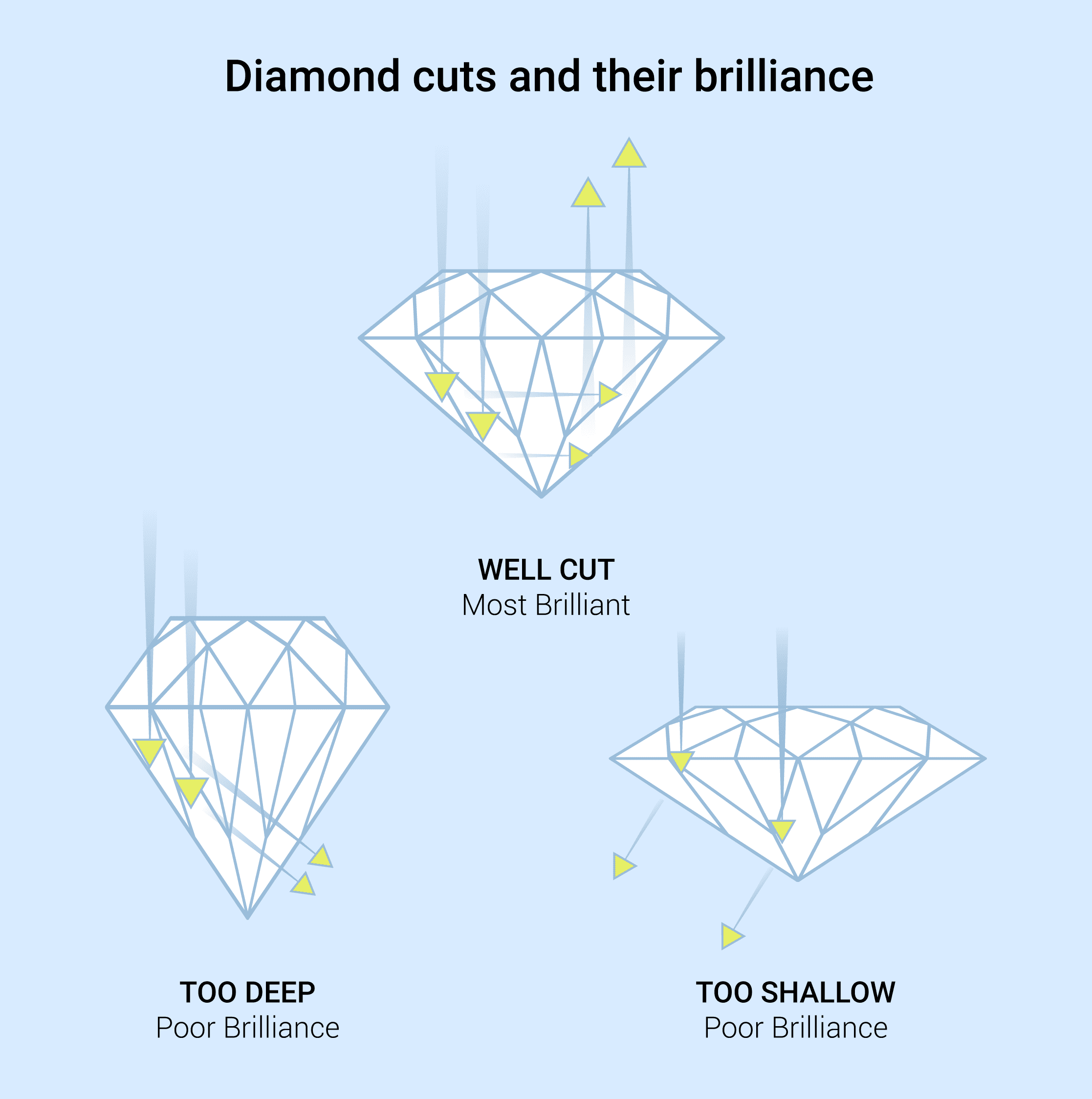
A diamond size chart can help you determine what might be the right carat weight for you by providing a mm to carat comparison. The diamond carat size chart is meant to be a reference point, as diameters of diamonds vary based on cut quality.
In the diamond size chart below, we display the diamond’s diameter mm to carat weight based on averages of round brilliant diamonds. For example, a round diamond’s diameter of 9.00mm to carat is 2.75ct on average.
| Round MM Size | Round Carat Weight |
|---|---|
| 4.0mm diameter | 0.25 ct |
| 5.1mm diameter | 0.5 ct |
| 5.8mm diameter | 0.75 ct |
| 6.4mm diameter | 1.0 ct |
| 6.9mm diameter | 1.25 ct |
| 7.3mm diameter | 1.5 ct |
| 7.7mm diameter | 1.75 ct |
| 8.1mm diameter | 2.0 ct |
| 8.5mm diameter | 2.25 ct |
| 8.9mm diameter | 2.5 ct |
| Round MM Size | Round Carat Weight |
|---|---|
| 9.0mm diameter | 2.75 ct |
| 9.3mm diameter | 3.0 ct |
| 9.5mm diameter | 3.25 ct |
| 9.75mm diameter | 3.5 ct |
| 9.9mm diameter | 3.75 ct |
| 10.1mm diameter | 4.0 ct |
| 10.43mm diameter | 4.25 ct |
| 10.63mm diameter | 4.5 ct |
| 10.83mm diameter | 4.75 ct |
| 11.01mm diameter | 5.0 ct |
*Sizing of diamonds is based on averages for a brilliant round diamond. Consult with a professional member of our Diamonds Pro team for more details.
To imagine the diamond sizes even better, take a look at this simple image comparison to a US quarter:
*This graphic shows mm to carat for various carat weights of a round diamond.
See below the average measurements of the basic carat weights of each shape:
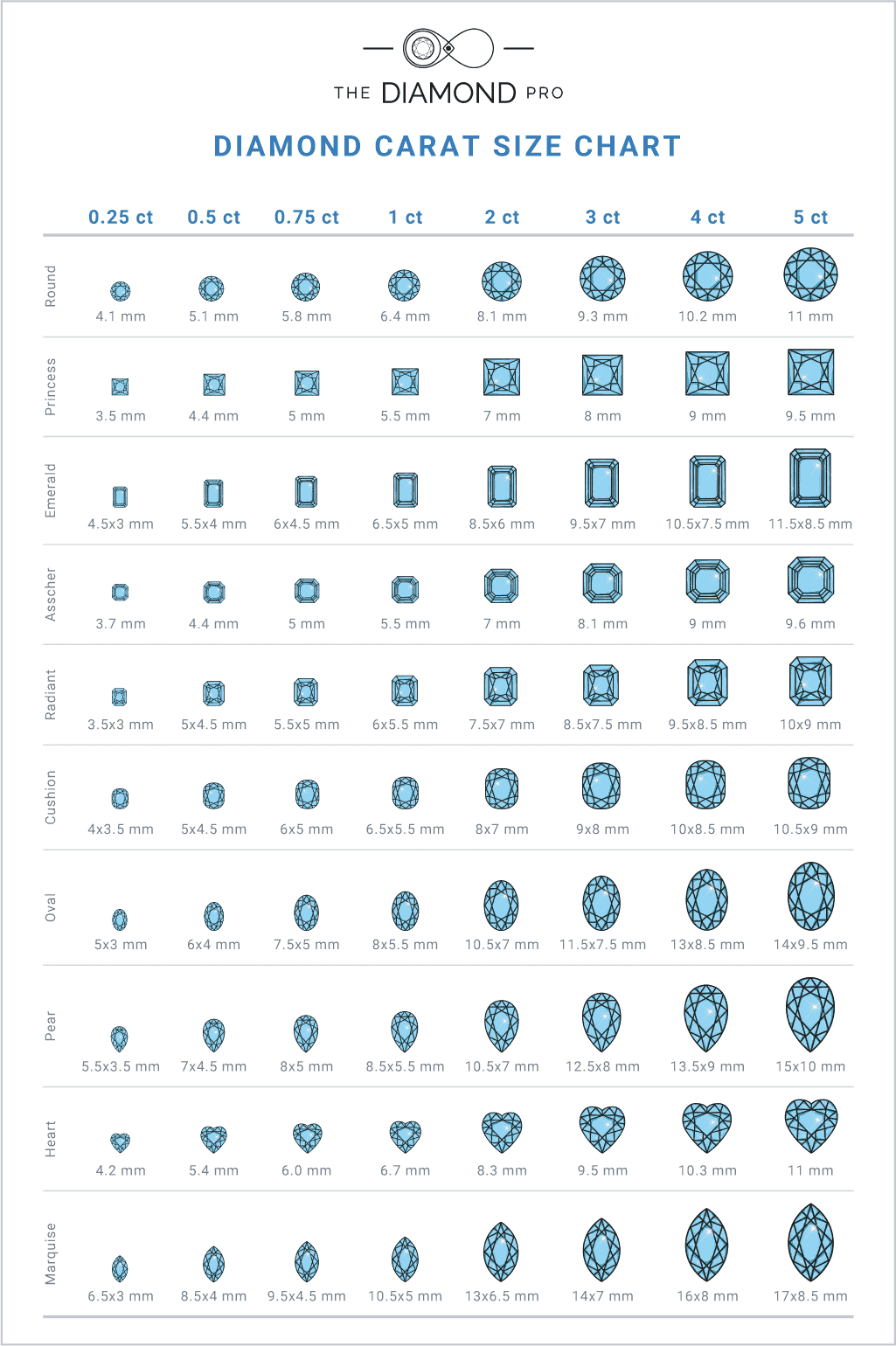
According to Wikipedia, the term diamond carat comes from the Greek word meaning “fruit of the carob tree.”
But you should understand that carat is actually a measurement of weight, not size. One carat is equal to 0.2 grams, or 200 milligrams. So diamond carat size is something of a misnomer, as a diamond’s carat doesn’t tell you exactly how big or small it is – though there is a correlation. As GIA, the worlds leading diamond grading lab, says “carat weight seems like a straightforward measurement, but there is more to it than a simple number”.
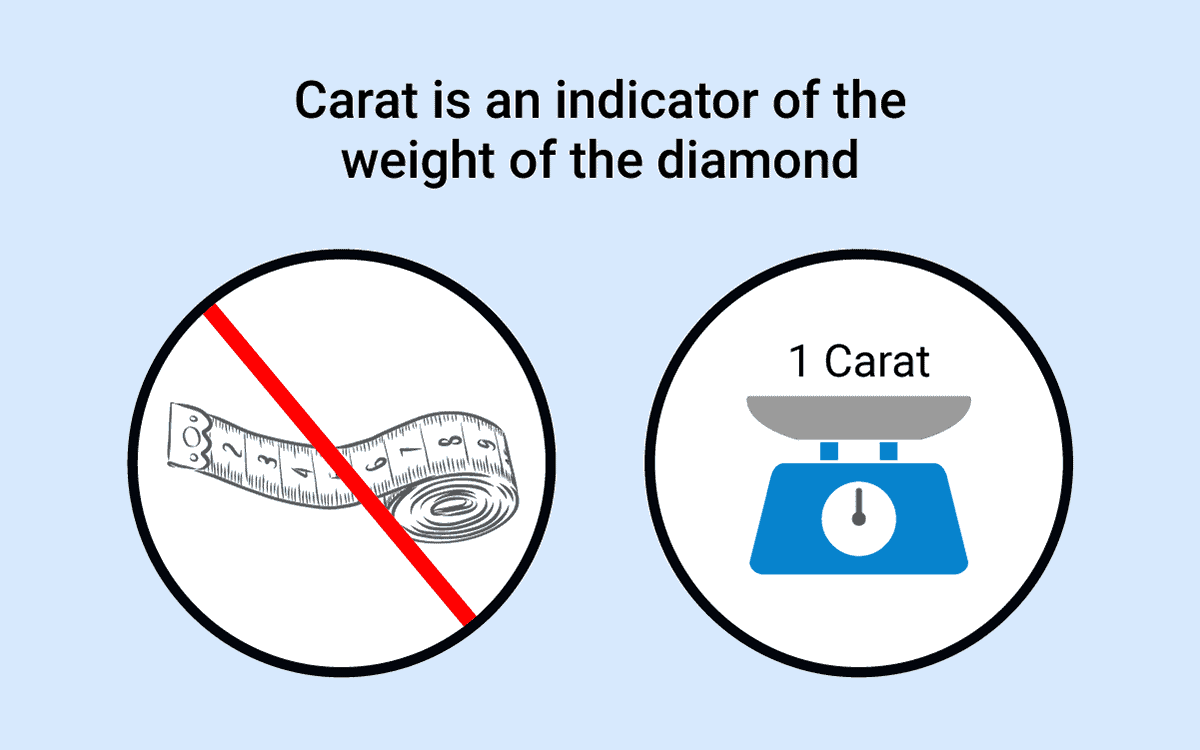
In ancient times, the seeds of the carob pod were used as standards for weight measurements, since the size of their seeds were almost always identical. This provided a natural standard of measurement.
In 1907 at the Fourth General Conference on Weights and Measures, it was agreed that a modern diamond carat should equal precisely 200 milligrams. This is technically known as a metric carat, and is the standard diamond carat weight that is used universally today.
The truth is, it doesn’t matter. Think about it. When you look at a diamond set in a ring, what does your eye see? Does your eye see weight, or does your eye see physical size? Obviously, your eye can only see physical dimensions—light doesn’t carry weight information back to your eye.
For example, you may not see the difference between this G color diamond from James Allen and this H color diamond. But you will definitely see the difference between those one carat diamonds and this 1.50ct diamond from James Allen.
Pro Tip: Carat is just weight. People see size not weight, particularly the face of the diamond. You might think it’s worth getting this 1.50ct diamond from Blue Nile even though it is poorly cut. In truth, this 1.30ct from BN will be far more brilliant and will appear to be the same size (they have the same diameter).
If you’re not sure how a certain carat size may look on your finger, check out James Allen’s carat weight tool. They show different diamond sizes on a woman’s hand using a simple sketch.
And if you think about it even more, your eye also doesn’t see the total physical size of the diamond, because most of it will be covered in jewelry. All you can really see when you look at a diamond is the size of its surface area on the top of the diamond, as displayed above in our diamond carat size chart.
However, carat weight is important when it comes to the diamond price. And where do you find the actual diamond carat weight? That’s where a certificate, such as GIA, comes into play. It includes all the diamond details you’re ever going to need.
You are best off asking one of our experts to guide you through this process. They will be able to help you find the balance between “getting the biggest diamond” and “not wasting money to gain carat size that won’t be noticeable.”
For a round diamond, that’s the diameter, and for other shapes, it’s a function of length and width. For simplicity’s sake, for the rest of this article, I will refer to diameter, but what I am writing applies equally to non-round shapes.
Even though this article is about carat size, eye-cleanliness is an important part of picking out a diamond. In our opinion, a consumer’s goal should be to find the cheapest (in regards to clarity; other factors matter as well) “eye-clean” diamond you can find. We use “eye-clean” to describe diamonds that may have inclusions if you look at them with a magnifying glass (or microscope or loupe), but the typical person can’t see the inclusion with their naked eye.

We have recently developed Ringo, a patented artificial intelligence model, that can examine videos of diamonds and determine if they are eye-clean. Ringo will also filter for other parameters like making sure the diamond is well-cut, doesn’t have fluorescence issues and will match the style setting you choose.
Now, obviously, there is a direct correlation between the diamond carat weight and the diameter of a diamond. It’s mathematically impossible for a 0.05ct diamond to have more surface area than a 1 carat diamond.
But because cut qualities can vary greatly, there is a vast amount of variance in the range of possible diameters for any given carat weight.
In my experience at Leo Schachter, a 1 carat diamond ring can have a diameter that ranges from 5.60mm (a horrifically ugly deep diamond) all the way to about 6.60mm (a shallow “flat” diamond).
Take a look at these three diamonds. They are all the same exact carat weight – 1.20ct.
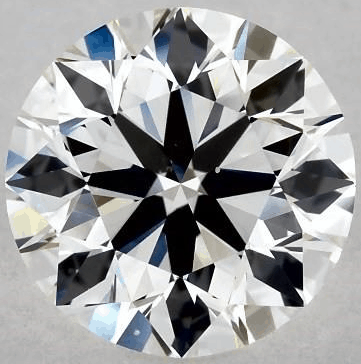

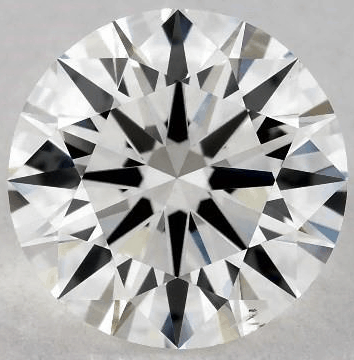
The first diamond we found on James Allen is very deeply cut. You can see the diamond is very dark in the middle and has a diameter of 6.73mm.
The second diamond from James Allen is very shallow and has a diameter of 7.03. This diamond looks glassy and won’t have much sparkle in natural light.
The third diamond from James Allen looks exactly like a round diamond should look. The proportions are perfect and the diamond will be very brilliant.
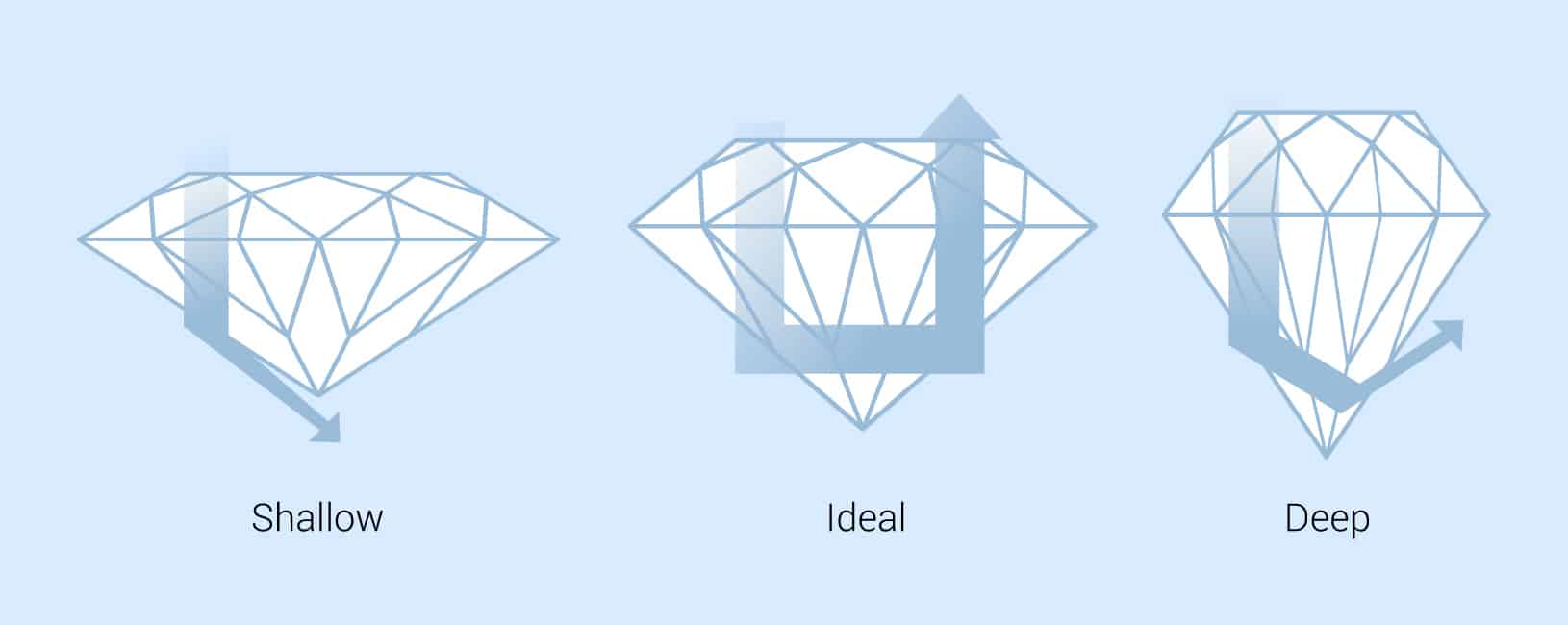
A one carat round diamond will usually have a diameter of 6.4mm, which comes out to approximately 1/4 of an inch.
A half carat diamond is usually 5.1mm in diameter. That is 1/5th of an inch. To compare that, a one carat diamond is 6.4mm. So while the one carat is double the weight, the face of the half carat diamond is only 21% smaller.
And how much does it weight? It weighs exactly half of a one carat diamond. Half carat diamonds are also referred to as ½ carat diamonds, .5 diamonds, 0.5ct diamonds, or 50 point diamonds.
Examples of beautiful half carat diamonds include this round brilliant from James Allen and this cushion cut diamond from Blue Nile. See our diamond size chart above for mm to carat for a half carat diamond.
A 1/4 carat round diamond will typically have a diameter of 4.0mm, or 0.15 inches.
Yes, lab-grown diamonds weigh the same, and are measured the same in terms of weight, as natural or Earth-grown diamonds.
Lab diamonds are exactly the same, chemically and physically, as diamonds formed naturally in the Earth. They are graded the same way as well, across the 4 C’s, which includes carat weight.
That means everything in this article, such as how carat weight translated to actual carat size, applies to diamond sizes for both lab-grown and natural diamonds.
Anything above 0.75ct (5.8mm for a round diamond) can be considered a good size for a diamond. The ideal size really depends on your budget and your taste. Some people don’t like anything above 0.50ct and for some, a 2ct diamond is too small. It’s also important to take into account more than just size – a large, yet low-quality diamond will look worse than a smaller diamond with better grades in other areas.
A 0.25ct diamond will be worth around $400-$600, depending on its other characteristics, such as color, clarity, cut quality, and shape.
A 2 carat diamond is quite a bit above average, and can certainly be considered a big diamond. The average diamond size is in the range of 1.00 and 1.2 carats.
A 0.50 carat diamond is below average, but that doesn’t mean it’s too small. A half carat diamond can still look beautiful in an engagement ring, assuming it’s well-cut and has good grades in color and clarity.
So as you can see, while weight, as one of the 4 C’s of diamonds, should matter to you because it will help determine how much you are going to pay, what you should really be focusing on is the diamond cut and diameter.
After all, wouldn’t you rather have a perfectly cut 0.90ct Brian Gavin Signature cut diamond that is 6.2mm and looks fantastic yet is cheaper than a 1.00ct diamond that is only 6.1mm and looks terrible?
If you need help searching for a diamond, feel free to contact our experts. We have years of expertise in the diamond industry, and we can assist you with any questions that come up during your search, related to diamond carat size or anything else. We’ll help you judge whether a higher-carat diamond is really worth the money, so you can come out with the perfect diamond for your budget.
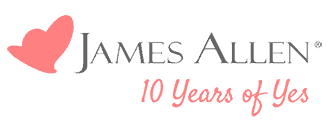



Before you buy a diamond, get personal buying advice from industry veterans. We'll help you get the best diamond for the money.
DISCLAIMER: We don't use your email for marketing. Period.
A diamonds’ price is determined primarily by the 4 Cs of the diamond. On the wholesale level, diamond prices are first based on a diamond shape and
Buying an engagement ring is often one of the first major purchases in a person's life. The process can be fraught with tension as there are so m
A wide range of 1 carat diamonds exist both in online markets and local diamond jewelry stores. Not only are there significant differences in beauty
Please enter your email address to receive your 25% off coupon code:
Here is your coupon code: GFDSF3GF